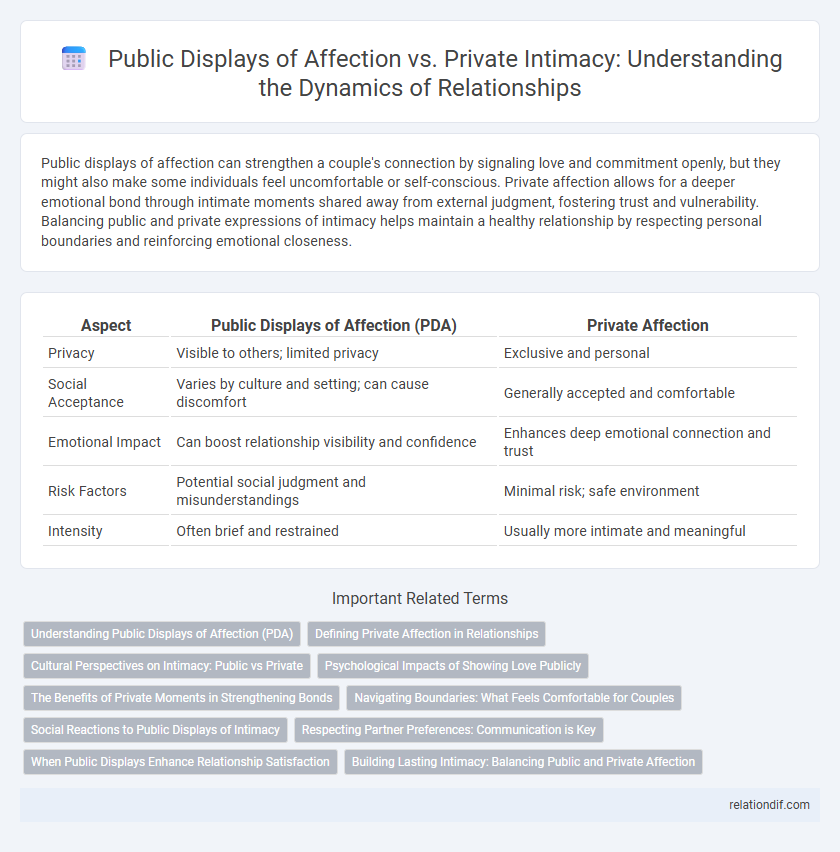Public displays of affection can strengthen a couple's connection by signaling love and commitment openly, but they might also make some individuals feel uncomfortable or self-conscious. Private affection allows for a deeper emotional bond through intimate moments shared away from external judgment, fostering trust and vulnerability. Balancing public and private expressions of intimacy helps maintain a healthy relationship by respecting personal boundaries and reinforcing emotional closeness.
Table of Comparison
| Aspect | Public Displays of Affection (PDA) | Private Affection |
|---|---|---|
| Privacy | Visible to others; limited privacy | Exclusive and personal |
| Social Acceptance | Varies by culture and setting; can cause discomfort | Generally accepted and comfortable |
| Emotional Impact | Can boost relationship visibility and confidence | Enhances deep emotional connection and trust |
| Risk Factors | Potential social judgment and misunderstandings | Minimal risk; safe environment |
| Intensity | Often brief and restrained | Usually more intimate and meaningful |
Understanding Public Displays of Affection (PDA)
Public displays of affection (PDA) encompass physical expressions like hand-holding, hugging, and kissing in social settings, reflecting emotional closeness visible to others. Understanding PDA involves recognizing cultural norms, personal comfort levels, and social contexts that influence how intimacy is shared publicly. Studies highlight that respectful PDA fosters positive social bonding but may vary significantly across societies with differing values on privacy and expression.
Defining Private Affection in Relationships
Private affection in relationships involves intimate gestures and emotional expressions shared away from public view, fostering a deeper connection and trust between partners. These moments, such as whispered words, gentle touches, and personalized rituals, create a safe space for vulnerability and reinforce emotional bonds. Prioritizing private affection helps couples develop a strong foundation beyond the performative nature of public displays, enhancing long-term relational satisfaction.
Cultural Perspectives on Intimacy: Public vs Private
Cultural perspectives on intimacy significantly influence how public displays of affection (PDA) are perceived and practiced, varying widely across societies. In many Western countries, PDA such as holding hands or kissing is generally accepted and seen as a natural expression of love, while in more conservative cultures, such acts are reserved strictly for private settings to maintain social decorum and respect traditional values. These differing norms reflect underlying cultural attitudes toward privacy, respect, and the boundaries of personal and communal spaces in intimate relationships.
Psychological Impacts of Showing Love Publicly
Showing love publicly can enhance feelings of security and validation within relationships, boosting partners' self-esteem and reinforcing emotional bonds. Public displays of affection (PDAs) often signal commitment and increase happiness by fostering social support and acceptance from peers. However, excessive or unwanted PDAs may cause discomfort or stress, highlighting the need for mutual boundaries to maintain psychological well-being.
The Benefits of Private Moments in Strengthening Bonds
Private moments foster deeper emotional connections by allowing couples to express vulnerability without social pressures. These intimate interactions enhance trust and communication, creating a safe space for genuine affection. Research shows that couples who prioritize private affection report higher relationship satisfaction and resilience.
Navigating Boundaries: What Feels Comfortable for Couples
Navigating boundaries in intimacy involves understanding each partner's comfort level with public displays versus private affection. Couples often find balance by openly communicating personal preferences and respecting differing views on expressions of love in social settings. Creating mutual agreements about when and where to show affection helps maintain emotional security and strengthens trust.
Social Reactions to Public Displays of Intimacy
Public displays of intimacy often elicit varied social reactions influenced by cultural norms, with some societies embracing open expressions while others view them as inappropriate or disrespectful. These reactions can include verbal comments, judgmental glances, or even intervention, reflecting underlying values about privacy and decorum in public spaces. Understanding these social dynamics is crucial for navigating the balance between expressing affection and respecting communal comfort levels.
Respecting Partner Preferences: Communication is Key
Respecting partner preferences in intimacy demands open and honest communication to understand boundaries around public displays of affection versus private moments. Clear discussions help partners express comfort levels, ensuring respect for individual needs without assumptions. Prioritizing mutual consent fosters trust and strengthens emotional connection in the relationship.
When Public Displays Enhance Relationship Satisfaction
Public displays of affection (PDA) can enhance relationship satisfaction by signaling commitment and creating a sense of belonging between partners, as supported by research in social psychology. Couples who engage in moderate PDA often report higher levels of trust and emotional connection, especially in cultures that value expressiveness. However, the positive impact of PDA is contingent on mutual comfort and social context, reinforcing intimacy through shared acknowledgment without infringing on private boundaries.
Building Lasting Intimacy: Balancing Public and Private Affection
Balancing public displays of affection with private moments fosters lasting intimacy by nurturing trust and emotional connection in relationships. Public expressions, like hand-holding or light touches, validate affection and build social bonds, while private affection deepens vulnerability and reinforces personal commitment. Prioritizing both forms of affection creates a harmonious dynamic that strengthens emotional intimacy and relationship resilience.
public displays vs private affection Infographic

 relationdif.com
relationdif.com